A particle of mass m and charge (-q) enters the regions between the two charged plates initially moving along x-axis with speed vx (like particle 1 in.) The length of plate is L and an the particle at the far edge of the plate is qEL2/(2mv2x).
Let a particle of mass m, charges -q and initial speed vx along x-axis enters a uniform electric field region at O. The field →E is along y-axis as shown in and extends to a length L.
As there is no field along x-axis , velocity vx along x- axis remains uncharged and time taken by charges particle to cross the field t=Lvx .
Force experienced by charged particle along y-axis.
∣∣∣→F∣∣∣=−q→E towards +ve charged plate.
∴ Acceleration of charged particle along y-axis ay=Fm=qEm (towards +ve charged plate).
∴ Deflection suffered by charged particle along y-axis,while crossing the electric field, is given by y=12ayt2=12×(qEm)×(Lvx)2=qEL22mv2x (towards +ve charged plate)
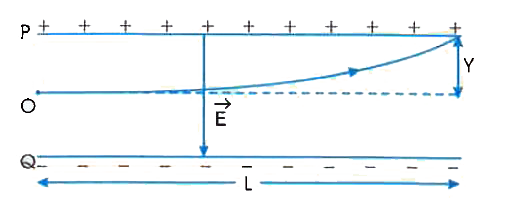
Topper's Solved these Questions
- ELECTRIC CHARGES AND FIELDS BOOK - U-LIKE SERIESCHAPTER - ELECTRIC CHARGES AND FIELDS EXERCISE - CASE BASED/ SOURCE -BASED INTEGRATED QUESTIONS
14 Videos
- ELECTRIC CHARGES AND FIELDS BOOK - U-LIKE SERIESCHAPTER - ELECTRIC CHARGES AND FIELDS EXERCISE - MULTIPLE CHOICE QUESTIONS
30 Videos
- ELECTRIC CHARGES AND FIELDS BOOK - U-LIKE SERIESCHAPTER - ELECTRIC CHARGES AND FIELDS EXERCISE - SELF ASSESSMENT TEST (SECTION-B) (VERY SHORT ANSWER QUESTIONS)
4 Videos
- DUAL NATURE OF RADIATION AND MATTERBOOK - U-LIKE SERIESCHAPTER - DUAL NATURE OF RADIATION AND MATTEREXERCISE - SELF ASSESSMENT TEST SECTION-C (VERY SHORT ANSWER QUESTIONS)
3 Videos
- ELECTROMAGNETIC WAVESBOOK - U-LIKE SERIESCHAPTER - ELECTROMAGNETIC WAVESEXERCISE - SELF ASSESSMENT TEST (SECTION C)
1 Videos
Similar Questions
A particle of mass m and charge -q enters the region between the two charged plates initially moving along x-axis with speed vx as shown in figure. The length of plate is L and a uniform electric field E is maintained between the plates. The vertical deflection of the particle at the far edge of the plate is
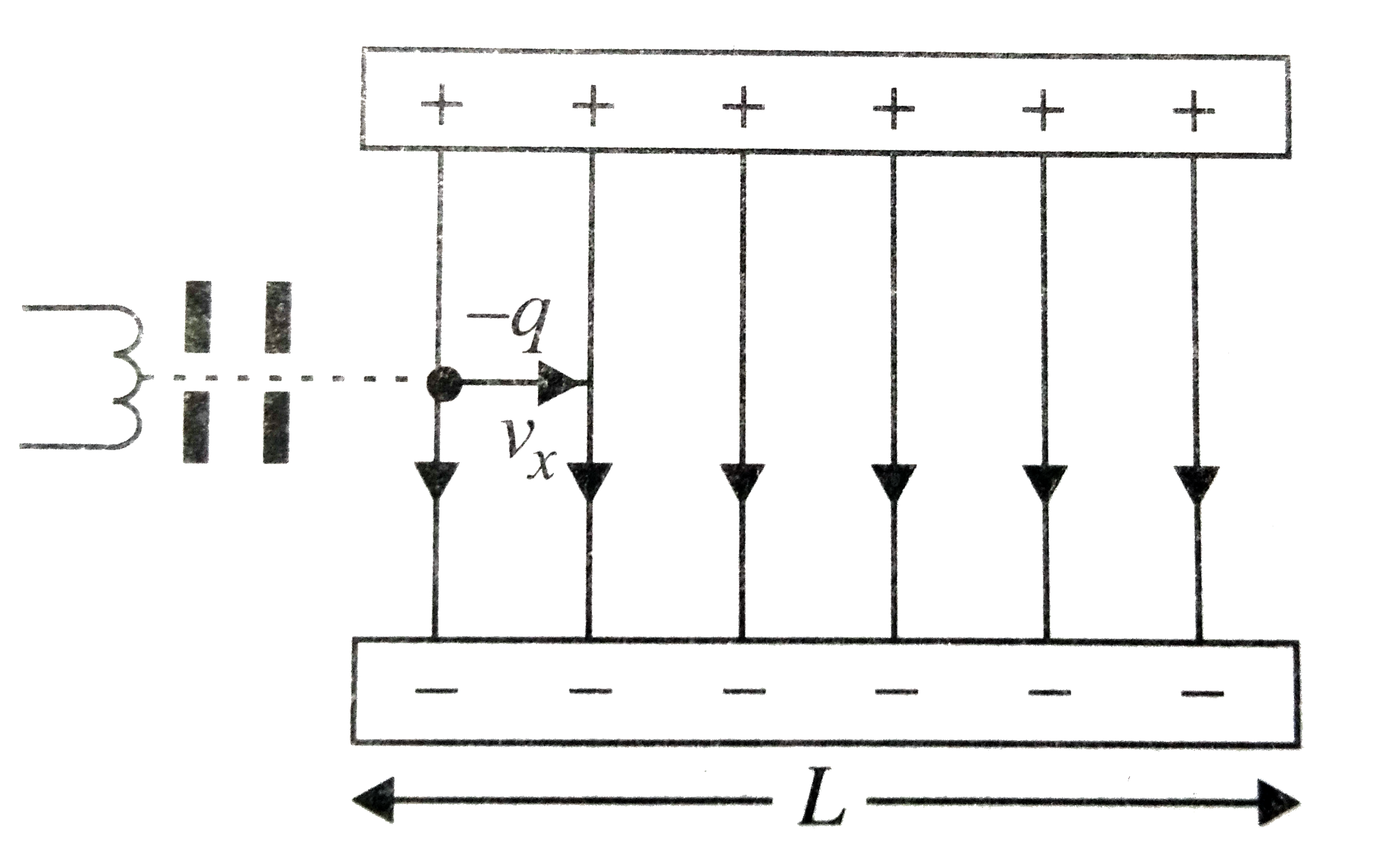
View SolutionA paraticale of mass m and charge (−q) enters the region between the two charged plates initially moving along x-axis with speed vx. The length of plate is L and a uniform electric field E is maintained between the plates. Show that the verticale deflection of the particle at the far edge of the plate is qEL2/(2mv2x). Compare this motion with motion of a projectille in gravitional field.
View Solution
Knowledge Check
Two recangular plates A and B placed at a distance 2a apart, are connected to a battery to produce an electric field. There are insulators between plantes C and other two plates. A magnetic field exists along z-axis. A charged particle of mass m and charge q passes through a hole at the middle of the plate A with velocity v and strikes at Q which is the middle of the bottom edge of plate B after passing through a hole inplate C. If E=mv2/qa, what will be the speed of the particle at Q?
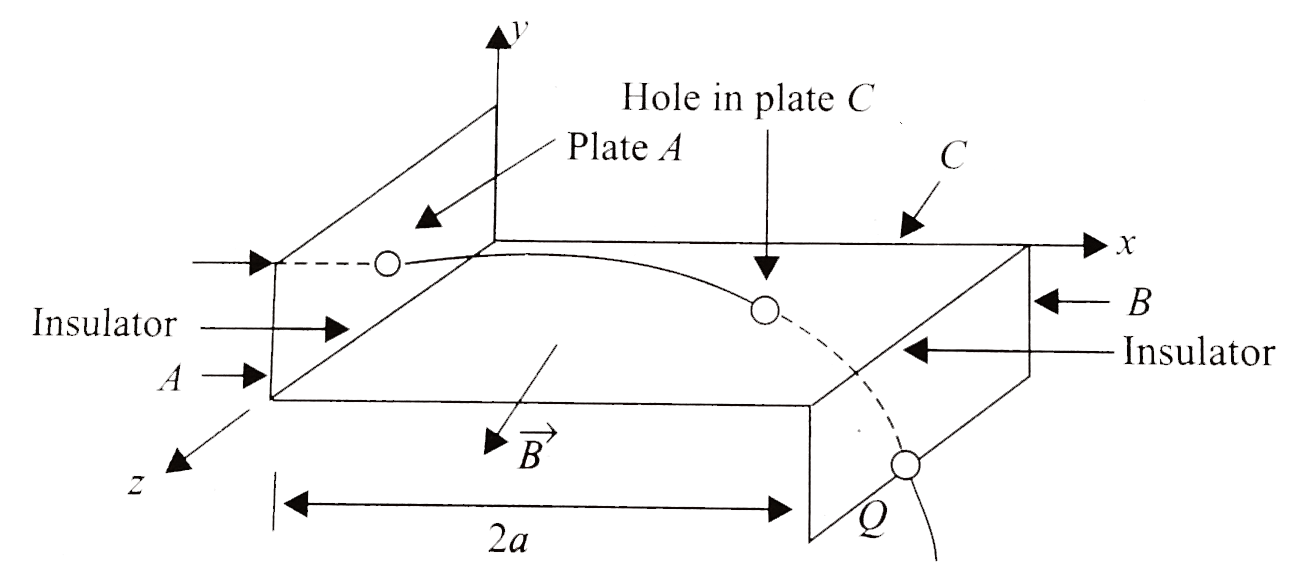 Av√2B2vCv√5Dv√3
Av√2B2vCv√5Dv√3
A particle of mass m and charge(-q) enters the region between the two charged plates intially moving along x - axis with speed Vx . The length of plate is L and a uniform electric field E is maintained between the plates . Show that the verticles deflection of the particle at the far edge of the palte is qEL2/(2mv2x).
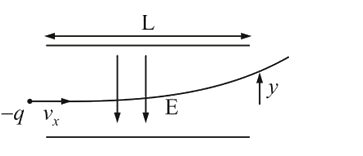
View SolutionFigure shows an assembly of deflecting plates A and B ofan ink-jet printer which causes moving ink droplets to deflect at desired displacements by continuously varying electric field between the plates. An ink drop with a mass m=1.3×10−10kg and a negative charge of magnitude q=1.5xx10−13C enters the region between the plates, initially moving along the x-axis with speed vx,=10m/s. The length of plates is L=1.6cm. The plates are connected with a varying voltage and thus produce an electric field at all points between them. Assume that field →E for some duration is constant and it is acting in downward direction as shown and has a magnitude of E=I.4×106N/C, find the vertical deflection of the drop at the far edge ofthe plate? As the gravitational force on the drop is very small relative to the electrostatic force acting on the drop, it can be neglected for this analysis. [6.4×10−4m]
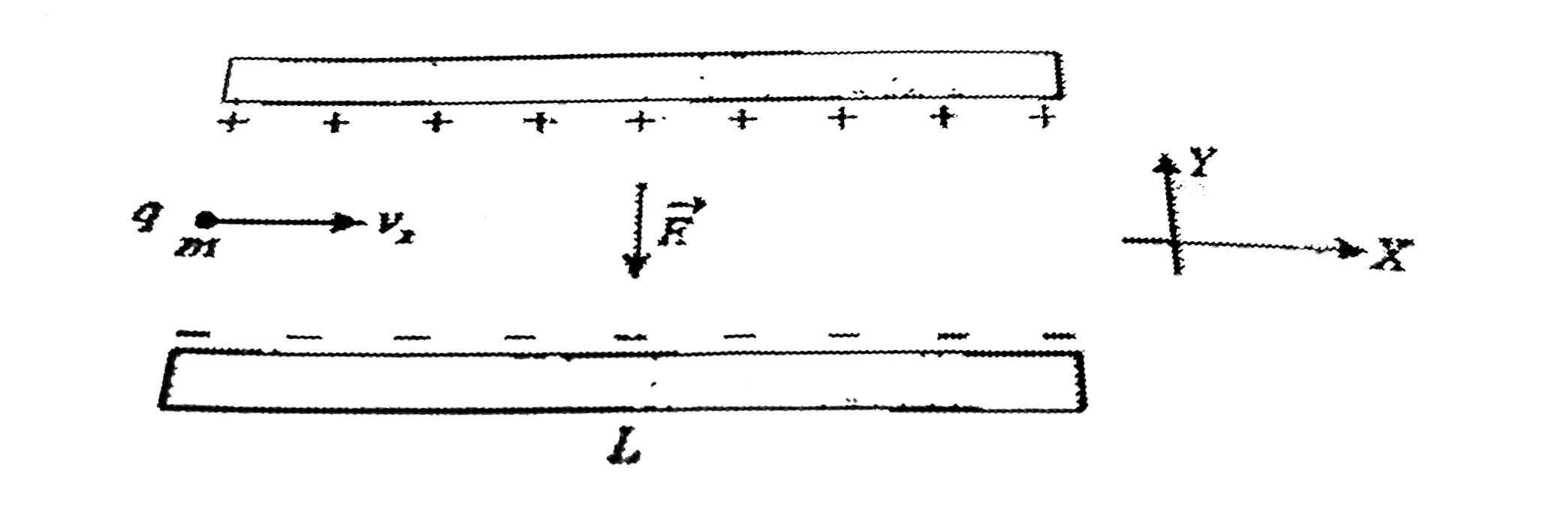
View SolutionA uniform electric field of magnitude E exists in between two parallel metal plates , as shown in the figure given below. One particle of mass m and charge q is projected along the central line between the plates. Particle just missed to strike upper plate , while coming out of plates. Find :
(a)Time taken by the particle to come out of plates.
(b)Speed of the particle as it comes out of plates.
(c) Angle of deviation suffered by particle. The length of the plates is L and the distance between the plates is d. Ignore gravity .
View SolutionA particle of mass m and charge q is released from rest in uniform electric field of intensity E. Calculate the kinetic energy it attains afect moving a distance x between the plates.
View SolutionTwo recangular plates A and B placed at a distance 2a apart, are connected to a battery to produce an electric field. There are insulators between plantes C and other two plates. A magnetic field exists along z-axis. A charged particle of mass m and charge q passes through a hole at the middle of the plate A with velocity v and strikes at Q which is the middle of the bottom edge of plate B after passing through a hole inplate C. If E=mv2/qa, what will be the speed of the particle at Q?

View SolutionA particle having a charge of 1.6x10−19C enters midway between the two plates of a parallel plate capacitor. The initial velocity of particle is parallel to the plates. A potential difference of300 Vis applied between the two plates. lfthe length of the plates is 10 cm and they are separated by 2 cm, calculate the greatest initial velocity for which the particle will not be able to come out of the plates. The mass of the particle is 12×10−24kg
[104m/s]
View SolutionA particle of mass m and charge +q enters horizontally with speed V0 midway between the horizontal plates of a parallel plate capacitor at time t=0. Separation between the capacitor plates is ‘d’ and it starts getting charged, by a constant current source, at time t = 0. Plate area of the capacitor is A. It was found that the particle just misses (to hit) the lower plate. Assume that the plates are quite long and acceleration due to gravity is g.
(a) Give a rough sketch of the path of the particle.
(b) Find the constant current (i0) supplied by the source to the capacitor.
Consider no magnetic force on the charge

View Solution
